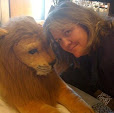Sunday, July 26, 2020
Men to Match My Mountains
 Posted by
JaneGS
Posted by
JaneGS
I like Irving Stone. He was in his heyday when I was in my youth, and so I always equate him with the blockbuster. I read his The Agony and the Ecstasy, a fictional bio of Michelangelo, before I went to Italy in 2015, and I've had his Men to Match My Mountains on my TBR shelf for years.
Men to Match My Mountains is non-fiction, published in 1956, and chronicles the story of the American West, 1840 to 1900. Bascially, there are 5 main story threads--the pioneer experience (including the Oregon, California, Mormon, and Santa Fe trails), the railroads (and all the backstabbing, manipulation, false advertising, backbreaking labor, and engineering that went into them), the growth of the major metropolitan areas (San Francisco, Sacramento, Denver, Salt Lake, and Los Angeles), the mines (gold, silver, god) and mining camps, and the Mormons (from polygamy to statehood),
Stone uses the stories of the men and women who starred in these main threads to paint a detailed account of the grit, heartache, and dreams it took to go create the American West so aptly portrayed in Hollywood's vision. While Stone doesn't completely ignore the Native American story, and he does give a fair account of the disgraceful Sand Creek Massacre and the string of broken treaties--it is not one of the main story threads that he follows completely.
Apart from the Native American part of the story, Stone really does recount virtually every story you've ever heard about the American West - the doomed Donner party, the explorations of Zebulon Pike and John Fremont, the scouting prowess of Kit Carson, the infamous Alferd Packer, the California 49ers, the Colorado 59ers, Horace and Baby Doe Tabor, Leland Stanford and his cohorts in the Southern Pacific, Pikes Peak or Bust, the crazy land rush of Los Angeles, the ties to Mexico, and on and on.
It is a long book, crammed full of details and stories. It is a product of the mid-50s, though progressive in its time, I believe, it is a bit dated. Nevertheless, it was a fun book to read--as a Westerner, I loved reading about so many places that I know well, have visited often, and have wondered about.
This is definitely one of my 2020 Big Book Summer books.
Subscribe to:
Post Comments (Atom)

Seems like a good accomplishment finishing it. An overall history lesson or refresher. Is it really readable? I'd like to try Stone sometime.
ReplyDeleteIt is very readable overall. Some parts drag a bit (the land deals, bank deals, and minutia of the railroad barons dealings), but other parts were absolutely enthralling.
DeleteSounds like a very comprehensive read! My mom used to really love reading Irving Stone. I wonder if she still has any of his books lying around.
ReplyDeleteThis is a book I have been wondering about because I read Irving Stone's novel Those who love about John and Abigail Adams and the book was well written. One book set partially in Manchester and partly in Utah during the 1840's is Saints by Orson Scott Card. Really exceptional novel
ReplyDeleteCongratulations on finishing a Big Book Summer book!
ReplyDeleteI've never heard of this book before, but it sounds fascinating - such an epic, covering so much, almost like a Michener novel.
Glad you enjoyed it -
Sue
P.S. You left your review link in the Sign-Up links list (it;s an easy mistake to make). If you get a chance, just had back to the challenge page to delete that link and add it to the Reviews list (the 2nd links list). Thanks!
2020 Big Book Summer Challenge
Thanks for the heads up, Sue. I added the link to the Reviews section :)
Delete